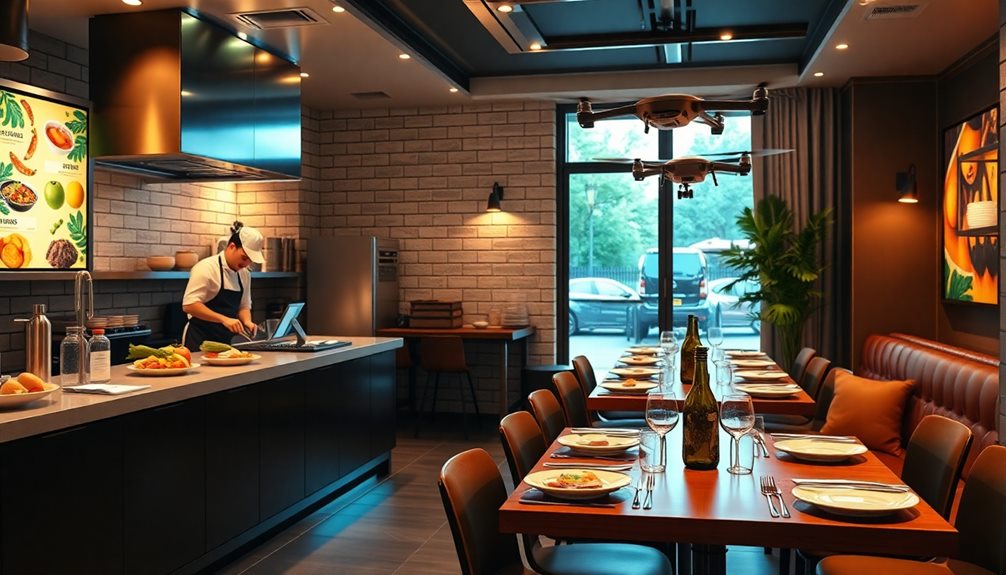Operators report that robotic kitchen arms offer consistent and precise food prep, improving quality and workflow efficiency. They can handle repetitive tasks and reduce errors, but often face challenges with integration, maintenance, and adapting to diverse recipes. While they boost safety and hygiene, some struggle with delicate ingredients or speed during complex steps. To learn more about how these systems are transforming kitchens, keep exploring the latest developments and operator insights.
Key Takeaways
- Operators report increased consistency and precision in food preparation, reducing human error and variability.
- Many highlight improved efficiency and reduced prep times, streamlining kitchen workflows.
- Maintenance and calibration are essential, with some noting technical malfunctions impacting operations.
- Users appreciate intuitive interfaces and automation features that simplify task management.
- Challenges include handling delicate ingredients and integrating seamlessly with existing systems.
Enhancing Consistency and Precision in Food Preparation
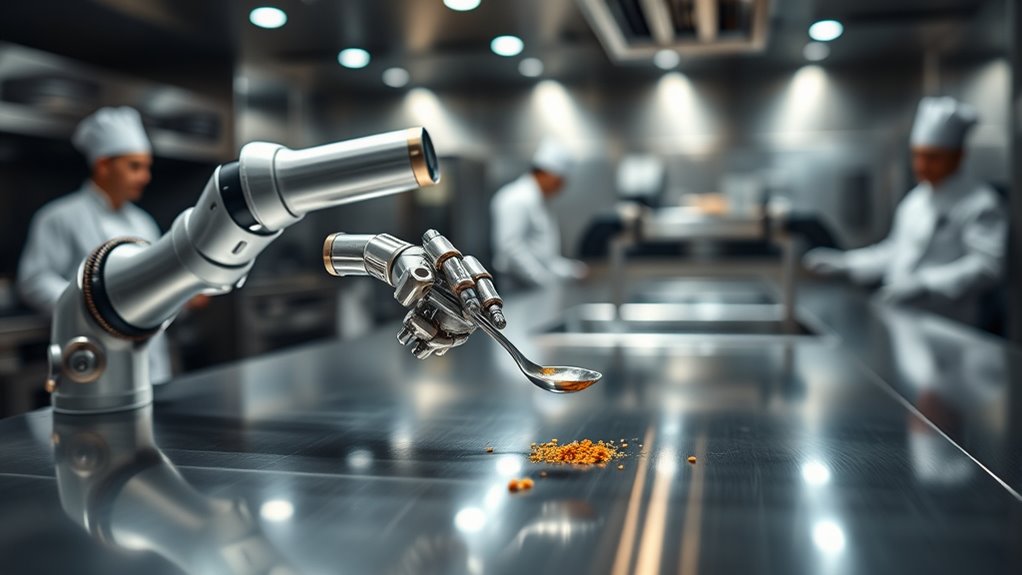
Robotic kitchen arms considerably improve consistency and precision in food preparation by executing tasks exactly as programmed. You’ll notice that each ingredient is measured, sliced, and cooked with uniform accuracy, reducing human error. This level of accuracy ensures every dish maintains the same quality, flavor, and presentation, no matter how many times it’s prepared. You won’t have to worry about variations caused by fatigue or distraction, as the robots follow exact instructions every time. This consistency is especially vital for high-volume kitchens or establishments demanding strict quality standards. By eliminating variability, robotic arms help you deliver reliable, exceptional meals consistently. Their precision not only elevates food quality but also streamlines the entire preparation process, making your kitchen more dependable and efficient. Additionally, automation technology plays a crucial role in maintaining these standards and optimizing kitchen workflows.
Streamlining Kitchen Operations and Workflow Efficiency
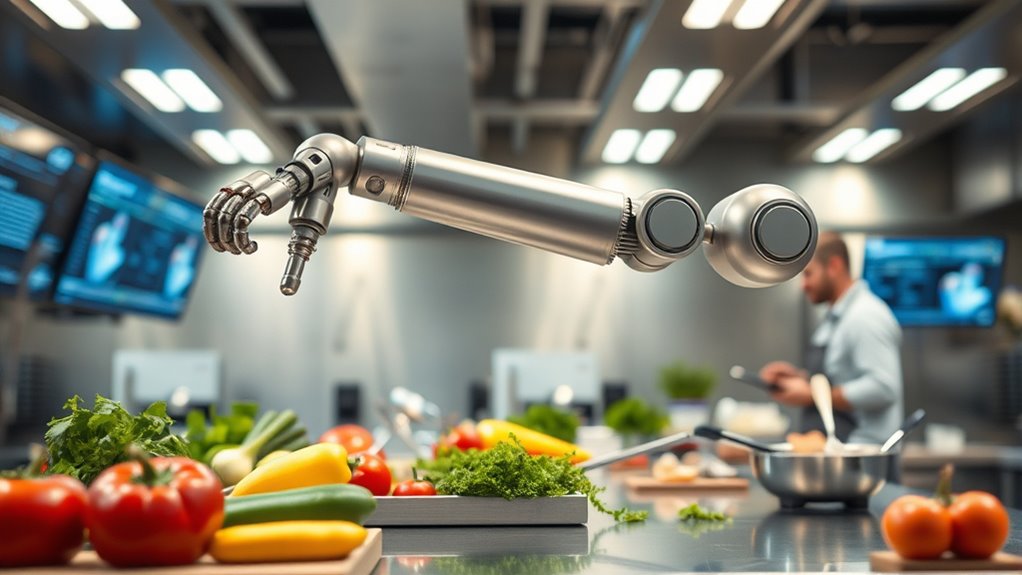
By automating repetitive tasks and coordinating various kitchen processes, robotic arms considerably enhance workflow efficiency. You’ll notice faster meal prep times, as robots handle routine activities like chopping, stirring, and plating without pause. This reduces bottlenecks and keeps the kitchen running smoothly, even during busy hours. Robotic arms can seamlessly integrate with existing systems, ensuring tasks are completed in the correct order and minimizing delays. You’ll also see improved staff productivity, allowing your team to focus on higher-level tasks and quality control. Additionally, automation minimizes errors and waste, leading to cost savings. Moreover, incorporating high-precision projectors can improve training and troubleshooting procedures in the kitchen environment. Overall, robotic kitchen arms streamline operations, creating a more organized, responsive, and efficient environment where meals are prepared faster and more consistently.
Challenges in Integration and Technical Maintenance
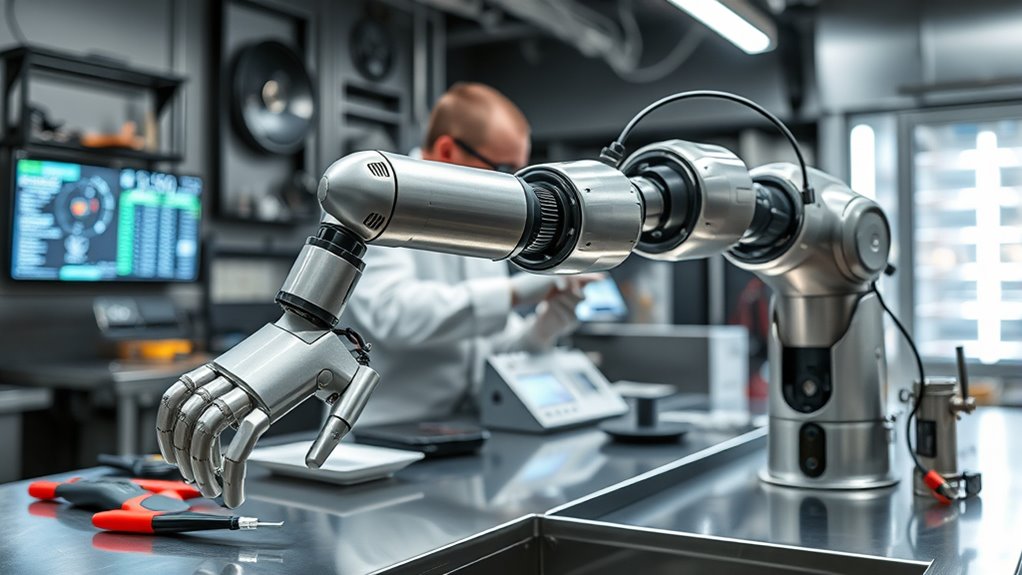
Integrating robotic kitchen arms into existing operations presents several technical challenges that can impact overall efficiency. You might encounter compatibility issues with current equipment, requiring extensive adjustments to guarantee seamless functioning. Calibration and synchronization of robotic arms with other appliances can be complex, demanding precise programming and testing. Frequent technical malfunctions or sensor errors may occur, leading to downtime and delays. Maintenance can also be demanding, as robotic systems need regular updates and troubleshooting, often requiring specialized knowledge. Additionally, integrating new technology might disrupt established workflows temporarily, causing delays and frustration. Guaranteeing reliable communication between systems is vital but can be difficult, especially in busy kitchens with limited space. Overcoming these hurdles is essential to maximize the benefits robotic arms promise. Furthermore, understanding industry trends can help operators anticipate future developments and adapt more effectively.
Impact on Kitchen Staff and Workforce Dynamics

As robotic kitchen arms become more common, you might find staff facing new adaptation challenges and changing roles. These shifts can influence employment trends, potentially reducing some positions while creating new opportunities. You’ll also notice a shift in skill requirements, with staff needing to develop technical expertise alongside traditional culinary skills. For example, understanding automation integration is increasingly important for effective operation and maintenance of robotic systems.
Staff Adaptation Challenges
The introduction of robotic kitchen arms can considerably disrupt traditional roles, forcing staff to adapt quickly to new workflows and technology. You may find yourself needing to learn new procedures, which can feel overwhelming at first. Resistance is common as staff adjust to changing responsibilities and the automation of tasks they once handled manually. Communication gaps can emerge if teams aren’t properly trained or if expectations aren’t clear. Some staff might worry about job security or feel their skills are becoming obsolete. This shift requires patience, ongoing training, and a willingness to embrace change. Proper training routines are essential to help staff gain confidence with new equipment and procedures. Without proper support, staff may experience frustration, reduced morale, or decreased efficiency. Managing these adaptation challenges is essential to ensuring a smooth integration of robotic arms and maintaining a productive work environment.
Workforce Employment Trends
The adoption of robotic kitchen arms is already reshaping employment patterns within the culinary workforce. You’ll notice shifts in staffing needs as automation handles repetitive tasks, reducing the demand for entry-level positions. Many kitchens are downsizing their human staff or reallocating roles toward oversight and maintenance. This trend pushes experienced workers into supervisory or specialized roles, changing traditional career paths. Some businesses report increased efficiency, which can lead to faster service and higher throughput, but also potential job reductions. While automation creates opportunities for tech-savvy employees, it challenges those with limited technical skills. Overall, workforce dynamics are evolving, prompting staff to adapt or face obsolescence. The industry experiences a realignment of roles, emphasizing flexibility and continuous learning. Additionally, understanding cotton candy sugar and its variations can inspire innovative menu offerings as kitchens explore new confectionery trends.
Skill Set Evolution
The emergence of robotic kitchen arms is driving a significant shift in the skill sets required of kitchen staff. You now need to be proficient in operating and maintaining advanced automation systems, beyond traditional cooking skills. Troubleshooting robotic equipment and ensuring smooth coordination between human and machine become essential. Soft skills like adaptability, problem-solving, and technical literacy are more valuable than ever. Staff must learn to interpret data from sensors and software, making decisions quickly in dynamic environments. Training programs are evolving to include robotics, programming basics, and system management. This shift demands continuous learning, pushing workers to upgrade their technical expertise. Additionally, understanding air purifier technologies and their maintenance can be beneficial in maintaining a healthy kitchen environment. Overall, your role is expanding from manual tasks to overseeing sophisticated technology, blending culinary skills with technical acumen.
Cost Considerations and Return on Investment

Investing in robotic kitchen arms requires careful consideration of upfront costs and long-term savings. These systems often involve significant initial expenses, including equipment, installation, and training. However, they can reduce labor costs and increase efficiency over time. By automating repetitive tasks, you may see lower staffing needs and minimized human error, leading to consistent product quality. Maintenance and software updates are ongoing expenses to factor in. While the initial investment might seem high, many operators report a strong return on investment within a few years due to increased productivity and reduced waste. Carefully analyzing your operation’s volume and workflow helps determine if robotic arms will pay off. Additionally, selecting high-quality equipment can improve longevity and performance, further enhancing your return on investment. Ultimately, weighing upfront costs against operational savings guides your decision to adopt automation.
Flexibility and Adaptability for Different Cuisines
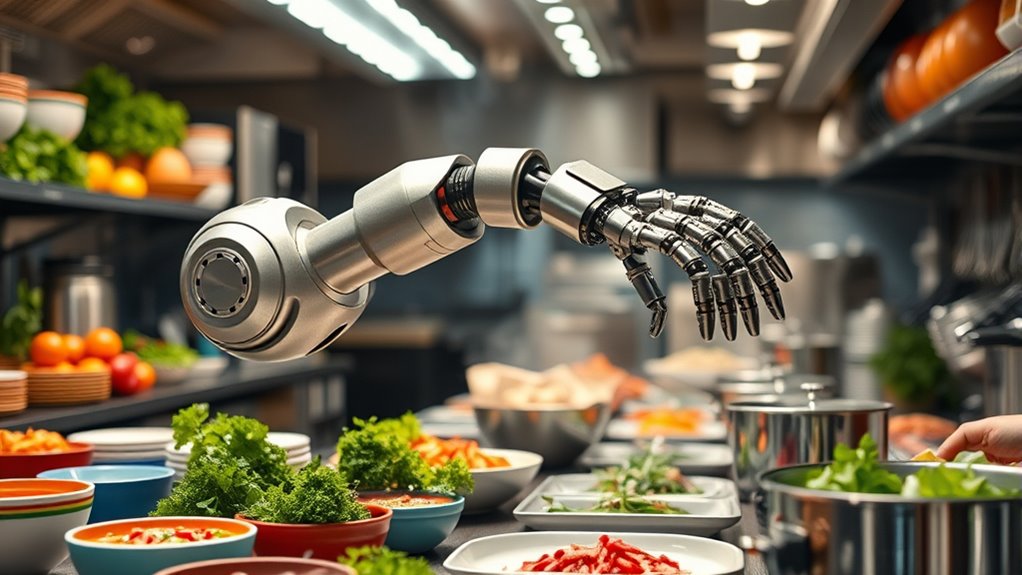
Robotic kitchen arms are designed to handle a variety of culinary tasks, making them highly adaptable across different cuisines. You can program them to perform diverse cooking techniques, from chopping vegetables to precise pouring, enabling quick adjustments for various recipes. Their flexibility allows you to switch between cuisines with minimal setup, whether you’re preparing Italian pasta, Asian stir-fry, or Mexican tacos. The arms can accommodate different utensils and tools, expanding their versatility. This adaptability not only saves time but also reduces the need for multiple specialized machines. As a result, you can efficiently serve a broad menu, meet customer preferences, and experiment with new dishes without extensive reconfiguration. Incorporating multi-functionality into their design further enhances their ability to perform a wide range of culinary tasks seamlessly. Overall, robotic kitchen arms offer the agility needed for diverse culinary environments.
Safety and Hygiene Improvements With Automation

Robotic kitchen arms can considerably reduce cross-contamination by minimizing human contact with food. They also guarantee consistent sanitation practices, keeping equipment and surfaces cleaner. As a result, food safety standards are improved, making your kitchen safer for everyone. Incorporating positive thinking techniques can further enhance staff morale and promote a safety-focused environment.
Reduced Cross-Contamination Risks
Automation in kitchen arms markedly reduces cross-contamination risks by minimizing human contact with food surfaces and utensils. This limits the transfer of germs and bacteria, creating a safer environment. Robotic systems follow strict cleaning protocols, reducing the chance of residual contamination. They also handle ingredients with precision, avoiding cross-contact between allergens or raw and cooked foods. To illustrate, consider the following:
| Aspect | Benefit |
|---|---|
| Automated cleaning | Ensures consistent sanitation after each task |
| Precise handling | Prevents cross-contact between different ingredients |
| Minimal human touch | Reduces bacteria transfer from operators |
| Consistent protocols | Maintains hygiene standards uniformly |
These factors collectively enhance food safety, making robotic kitchen arms a valuable tool in reducing contamination risks.
Consistent Sanitation Practices
Consistent sanitation practices are essential for maintaining high standards of safety and hygiene in the kitchen. Robotic arms can be programmed to follow strict cleaning cycles, ensuring every surface and utensil is sanitized regularly. This automation reduces human error, such as missed spots or improper cleaning techniques, leading to more reliable hygiene standards. You’ll find that robotic systems can operate during off-hours, minimizing downtime and ensuring the kitchen stays clean without interrupting food prep. Additionally, sensors and real-time monitoring help verify that sanitation procedures meet safety protocols. This consistency not only improves hygiene but also builds customer trust, as they see a commitment to cleanliness. Overall, automation helps you achieve a safer, more hygienic environment with less effort and greater precision.
Enhanced Food Safety Standards
By integrating robotic kitchen arms, you especially elevate your food safety standards. These systems reduce human contact with food, minimizing the risk of contamination. Robots follow strict hygiene protocols, ensuring consistent cleaning and sanitation routines. Their precise movements prevent cross-contact between raw and cooked ingredients, protecting against foodborne illnesses. Automated arms maintain accurate temperature controls, ensuring proper cooking and storage. They also track ingredient usage and expiration dates, reducing waste and preventing spoilage. With real-time monitoring, you can quickly identify potential safety issues and address them proactively. Overall, automation enhances hygiene, consistency, and compliance with health regulations. This not only safeguards your customers but also boosts your reputation for delivering safe, high-quality food.
User Experience and Ease of Operation

Robotic kitchen arms are designed to simplify cooking, making the process more accessible and less stressful for users. You’ll find that most systems feature intuitive controls, often through touchscreens or mobile apps, so you can operate them without extensive training. Setup is straightforward, and many robotic arms respond quickly to commands, helping you prepare meals efficiently. They handle complex tasks like chopping, stirring, and pouring, reducing the effort required on your part. Feedback from operators indicates that the interface is user-friendly, with clear instructions and responsive features. This ease of use encourages regular interaction, even for those with limited cooking experience. Overall, robotic kitchen arms aim to make cooking more convenient, saving you time and minimizing frustration in the kitchen.
Limitations and Areas for Technological Improvement
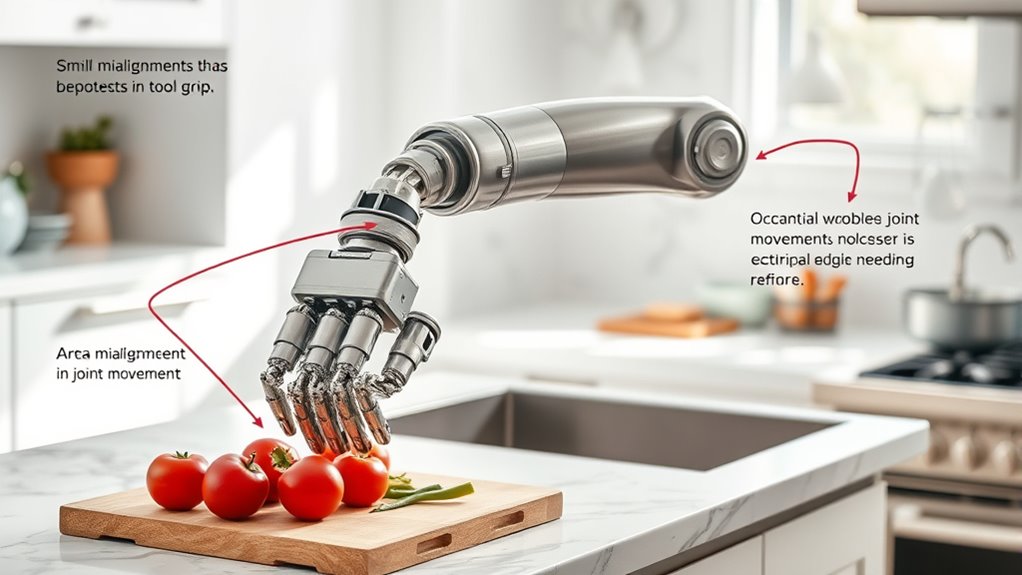
While robotic kitchen arms have made significant strides in user-friendliness, certain limitations still hinder their full potential. One major challenge is their limited adaptability to diverse kitchen environments and recipes. The arms often struggle with handling delicate ingredients or performing complex tasks that require fine motor skills. Additionally, their sensory systems aren’t yet advanced enough to detect subtle changes in texture, temperature, or consistency, which affects precision. The current technology also faces issues with speed and efficiency, especially during multi-step cooking processes. Integration with existing kitchen appliances remains inconsistent, making workflows less seamless. Improvements in AI, sensory feedback, and mechanical dexterity are essential to overcome these hurdles and unleash the full capabilities of robotic kitchen arms.
Future Trends and Expectations in Robotic Kitchen Technology

Future trends in robotic kitchen technology will likely see increased automation integration and smarter AI culinary innovations. These advancements could change how you prepare meals and influence the skills needed in the kitchen. Additionally, shifts in the workforce may occur as robots take on more cooking tasks, altering traditional roles.
Automation Integration Advances
As integration technologies evolve, we can expect robotic kitchen arms to become seamlessly embedded within smart home ecosystems, enhancing functionality and user experience. You’ll see smoother communication between devices, allowing the robot to coordinate with other smart appliances effortlessly. Automation systems will adapt more quickly to your preferences, making daily tasks more efficient. Expect real-time data exchange that improves precision and reduces errors.
- Compatibility across multiple platforms and brands
- Voice and app control for intuitive operation
- Automated recipe adjustments based on sensor feedback
- Enhanced security protocols for connected devices
- Predictive maintenance alerts to prevent downtime
These advances will make robotic kitchen arms more responsive, reliable, and integrated, transforming your cooking environment into a cohesive, intelligent space.
AI Culinary Innovations
AI culinary innovations are set to revolutionize your kitchen by enabling robotic arms to learn and adapt to your cooking style over time. Imagine a robot that recognizes your favorite recipes, adjusts seasoning to your taste, and suggests new dishes based on your preferences. These advancements will make your kitchen smarter and more personalized. Here’s how the future might look:
| Your Cooking Style | Robot’s Adaptation |
|---|---|
| Prefers spicy foods | Adds extra chili automatically |
| Likes quick meals | Preps ingredients faster |
| Enjoys experimenting | Suggests new flavor combinations |
Workforce Impact Shifts
Robotic kitchen technology is already beginning to reshape the workforce by automating routine cooking tasks and reducing the need for human labor in certain roles. As this trend advances, expect shifts in employment patterns and skill requirements. You might see fewer entry-level kitchen staff, but new opportunities will emerge in robot maintenance and programming. Training programs will likely evolve to focus on technical skills. Some roles may become more specialized, emphasizing quality control and system oversight. Automation could lead to shorter shifts and increased productivity, but also raise concerns about job displacement. To stay competitive, you’ll need to adapt by acquiring technical expertise and embracing ongoing learning. Ultimately, this shift promises a more efficient kitchen environment, but it also reshapes the human element in culinary work.
Frequently Asked Questions
How Do Robotic Arms Handle Complex or Customized Recipes?
You might wonder how robotic arms manage complex or customized recipes. They handle this by using advanced programming and adaptable software that allow you to input multiple steps and ingredient variations. Sensors and AI help them adjust in real time, ensuring precision and consistency. With user-friendly interfaces, you can easily customize recipes, and the robotic arms execute these instructions efficiently, making complex cooking tasks manageable and reliable.
What Are the Maintenance Requirements for Robotic Kitchen Systems?
Think of maintaining robotic kitchen systems like tending to a high-performance sports car. You’ll need to regularly check and clean the mechanical parts, lubricate joints, and update software to keep everything running smoothly. Replace worn-out components promptly and monitor for any signs of malfunction. Consistent maintenance guarantees your robotic arms operate efficiently, just like a well-tuned engine, preventing costly breakdowns and extending their lifespan.
How Do Operators Ensure Safety With Robotic Kitchen Arms?
You guarantee safety with robotic kitchen arms by following strict protocols, such as performing regular maintenance checks and safety audits. Always keep the system’s emergency stop functions accessible and test them frequently. Use proper protective gear, and ensure operators are well-trained on safe operation procedures. Keep the workspace clear of hazards, and stay alert for any unusual movements or sounds that might indicate a malfunction, preventing accidents before they happen.
Can Robotic Arms Be Integrated With Existing Kitchen Equipment?
You can integrate robotic kitchen arms with existing equipment by choosing systems compatible with your appliances and infrastructure. Many robotic arms come with adaptable interfaces or customizable software, allowing seamless connection to your current setup. You’ll need to guarantee proper installation and calibration, and possibly update some controls. This integration can improve efficiency, reduce manual effort, and create a more streamlined kitchen operation. Just plan carefully and work with experienced technicians.
What Training Is Necessary for Staff to Operate Robotic Kitchen Technology?
You need to understand that training for robotic kitchen technology isn’t just about pressing buttons. You must learn how to operate, troubleshoot, and maintain the equipment. Usually, manufacturers provide hands-on sessions and manuals, but it’s also helpful to have ongoing support and refresher courses. This way, your staff stays confident and efficient, turning what seems complex into a seamless part of your kitchen workflow.
Conclusion
As you consider adopting robotic kitchen arms, the promise of increased efficiency and consistency is tempting. But don’t overlook the hurdles—they might surprise you. Will future innovations solve current challenges or introduce new complexities? The evolution of kitchen automation is unfolding rapidly, and the next breakthrough could change everything. Stay tuned, because what’s coming next might just reshape how you cook and serve forever. The future of culinary automation is closer than you think.


